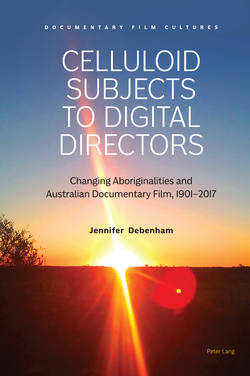Читать книгу Celluloid Subjects to Digital Directors - Jennifer Debenham - Страница 31
На сайте Литреса книга снята с продажи.
Reception and Distribution
ОглавлениеLike the film made by Spencer and Gillen, the images captured on Life in Central Australia, helped sustain and consolidate negative ideas about Aboriginal people as timeless; they were confined to the place of “deep history”, particularly regarding their perceived lack of technological progress through the images of the Cockatoo Creek film. The film was screened in universities to instruct a new generation of medical scientists and anthropologists, arguably prolonging this perception. According to the South Australia Museum’s curator: “the films were produced for educational purposes and commercially sold and loaned to individuals and institutions as a teaching tool, copies of these films are likely to exist in institutions throughout Australia and overseas”.22
Life in Central Australia has enjoyed only limited viewing to public audiences, screened primarily at key cultural institutions, such as universities as an educational tool and at theatre venues to interested groups of the public.23 However, today the film is intrinsic to understanding how the professional scientific community’s views of Aboriginal people were developed and expressed at the time; themes reflected in their work practices. The subtle reinforcement of racial ideology and the dissemination of evolutionary scientific discourses contained in the film simultaneously reflected and reinforced scientific paradigms current at the time of the film’s production, enabling the continued subjugation and objectification of Aboriginal people.
←45 | 46→
Showcasing SABAR’s field activities, the film provides the audience with an intimate observation of how the scientists interacted with the Warlpiri, Ngarti and Anmatjere peoples and how they conducted the often gruelling tests on them. The audience can see the types of conditions in which the scientists worked and the cordial relations they adopted with the Warlpiri, Ngarti and Anmatjere to ensure access to them as test subjects, eliding on film the tensions that must have been present. What the Warlpiri, Ngarti and Anmatjere thought of these inexplicable rituals remains a mystery. Importantly for the scientists, the film reinforces the proficiency of the scientists in the field and the diversity of their research projects in relation to the question of human evolution. The film gives no evidence that they gave much attention to the conditions being experienced by the Warlpiri, Ngarti and Anmatjere people who at the time were dealing with the trauma of dispossession, massacres and miscegenation. Like in the films of Spencer and Gillen, Aboriginal people were again depicted residing in the ethnographic present. The film implies the Warlpiri, Ngarti and Anmatjere people are culturally and genetically static, little more than repositories of biometric data conveniently available to establish baseline measurements used determine their degree of “authenticity” as genetically untainted individuals.
1 Warwick Anderson, The Cultivation of Whiteness: Science, Health and Racial Destiny in Australia. 2nd edn. Melbourne: Melbourne University Press (2005), 209.
2 Philip Jones, “South Australian Anthropological History: The Board for Anthropological Research and Its Early Expeditions”. Records of the South Australian Museum, 20 (1987), 78; Anderson, The Cultivation of Whiteness, 206.
3 Francis Galton, a cousin of Charles Darwin, was influenced by his cousin’s theory of evolution, On the Origin of Species (1859). A mathematician and statistician, Galton developed a theory about heredity, Hereditary Genius (1869) which formed the basis of the philosophy he named eugenics. Established in England in 1907 by social reformer Sibyl Gotto and then later in 1926 by Madison Grant in the US, eugenics societies promoted the advancement of the human race through hereditary and genetics. In the US, the society developed in a racist direction and also included the sterilisation of mental defectives and disabled people. Popular in the inter-war years, the dark side of eugenics associated with the Nazi holocaust fell from its height in popularity in the 1930s.
4 Jones, “South Australian Anthropological History”, 76.
5 Geoffrey Gray, A Cautious Silence: the politics of Australian anthropology. Canberra: Aboriginal Studies Press (2007), 60.
6 Frederick McCarthy, “Ethnographic Films on the Australian Aborigines”. Sydney: United Nations Educational, Scientific and Cultural Organization (UNESCO) (1966), 16.
7 David Piers Thomas, Reading Doctors’ Writing: Race Politics and Power in Indigenous Health Research, 1870–1969. Canberra: Aboriginal Studies Press (2004), 55.
8 Thomas, Reading Doctors’ Writing, 55.
9 Thomas, Reading Doctors’ Writing, 56.
10 Thomas, Reading Doctors’ Writing, 60.
11 Russell McGregor, Indifferent Inclusion: Aboriginal People and the Australian Nation, Canberra: Aboriginal Studies Press (2011), 9.
12 A phenotype is what an individual looks like. It is the physical expression of an individuals’ genetic makeup or genotype.
13 John B. Cleland, “Anthropological Expedition to Central Australia”. Medical Journal of Australia, 2 (1931), 793.
14 South Australian Museum, “Crayon drawings relating to the Cockatoo Creek expedition, Northern Territory, 1931. Board for Anthropological Research Expedition G”. <http://archives.samuseum.sa.gov.au/AA346/AA346-11.htm#BAR-00151> [Accessed 30 August 2016].
15 Cleland, “Anthropological Expedition to Central Australia”, 793.
16 This method of collecting blood was phased out the late 1970s when new technology was developed to protect pathology technicians from the risk of contracting hepatitis, AIDS and other blood borne infections from blood samples they were required to handle from patients.
17 McCarthy, “Ethnographic Films”, 16; South Australian Museum, “Curator’s Notes”, “Series AA346/09 – Films Recorded During the Board for Anthropological Research Expeditions, 1926–1966”, South Australian Museum, <http://samuseum.australia.sa.com/AA346/AA346-09
